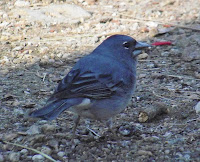So, I never intended for this to
become a travel blog so please forgive me for telling you about my recent field
trip to Tenerife. Which was by the way absolutely awesome.
Before we
get into what I got up to a bit about Tenerife itself. It is the
largest of the seven Canary Islands measuring around 800 km sq with a
population of about 900,000. The Canary Islands lie about 250 - 400 km of the
coast of Morocco but are actually part of Spain.
The
Canary Islands were formed through volcanic activity, the oldest islands being
those in the east (Lanzertote & Fuerteventura) and the youngest to the west
(Palma and Hierro). Tenerife itself is around 7 million years old, originally it
was three islands but continued volcanic activity shaped it into the island we
see today. Today the highest point on the island (and in Spain) is Mount
Teide at 3718 m above sea level. This volcano actually formed as a result of a
massive eruption of an even large volcano, Las Canadas, around 250,000 years
ago. The eruption caused a massive landslide forming the Vale of Orotava and
leading to a Tsunami on America's eastern seaboard. Tenerife is
considered volcanically active, with eruption occurring around once every 100
years.
Tenerife
is also important ecologically, containing many endemic (or near-endemic)
species. This includes thousands of invertebrate species, 140 species of
plants, 7 species of bird and several reptiles. The main reason for travelling
to Tenerife was to study these unique species and how they were adapted to and interact
with the environment.
The scene
is set, let’s find out about what I got up too.......
Day One -
Mount Teide & the Pine Forest
 |
| Mount Teide |
So the
week began with a bang (if you’ll pardon the terrible pun) when we spent the
day on Mount Teide. We arrived at the Rocks of Garcia and spent some time looking
at the geology of the formation as well as the different types of lava flow
found on the volcano. We walked around some of the caldera (volcanic crater) of
Las Canadas and studied and made field sketches of some of the native flora.
Due to the harsh conditions the plants found here
are highly adapted and unique with many being endemic.
 |
| Southern Grey Shrike |
Whilst on
the mountain I was keeping my eye out for birds, the highlights were very good
close views of both Southern Grey Shrike (Lanius meridionalis) and Berthelot’s Pipit (Anthus berthelotii).
 |
| Bethelot's Pipit |
The Pine forest
was also a very interesting place to visit. It was good to see a large area of completely
natural pine forest as opposed to the plantations we are so familiar with in
the U.K. The forest itself was also amazing due to the fact the it was so species
poor. The pine trees (the native tree Pinus canariensis) actively inhibit the growth
of other plants. Within the forest we saw a tunnel which is used to drain water
from the volcanic aquifer under Mount Teide.
 |
| The Native Pine Forest |
In the
Pine forest I had fleeting views of Tenerife Kinglet (Regulus (regulus) teneriffae) as well as African Blue Tit (Cyanistes
teneriffae) and Blue Chaffinch (Fringilla teydea).
 |
| Male Blue Chaffinch |
Day Two -
Malpais de Guimar
 |
| Canary Islands Spurge (it was at least 2.5 m tall) |
We spent
the second day undertaking transect surveys of vegetation at Guimar This is an area
of lava flow produced by a small volcano on the southern coast. We were looking
at the changes in vegetation from the coast inland. We found that in general
the species diversity increased inland due to the lower levels of salt found
there. Whilst we were here we had our first proper encounter with Euphorbia.
These are a genus of plants that look similar to cacti but are not related to
them (Cacti are found in the new world and Euphorbia in the old world). The
most spectacular of these was the endemic Canary Islands Spurge (Euphorbia
canariensis).
In terms
of bird life I had encounters with a Kestrel (Falco tinnunculus) which
had predated a lizard as well as a Spectacled Warbler (Sylvia
conspicillata).
Stay tuned for part 2, coming very soon.......
No comments:
Post a Comment